Phase Formation, Mechanical Strength, and Bioactive Properties of Lithium Disilicate Glass–Ceramics with Different Al2O3 Contents
Abstract
1. Introduction
2. Materials and Methods
2.1. Glass and Glass-Ceramic Preparation
2.2. Differential Thermal Analysis (DTA)
2.3. X-ray Powder Diffraction Analysis (XRD)
2.4. Field Emission Scanning Electron Microscopy (FE-SEM)
2.5. Mechanical test
2.6. Micro-Shear Bond Strength (μSBS)
2.7. In Vitro Test for Biocompatibility of the Material
2.7.1. Preparation of the Tested Materials
2.7.2. Culture of Osteoblast-Like Cells
2.7.3. Cell Attachment, Cell Viability, and Cell Proliferation by MTT Assay
2.7.4. Preparation of the Cell Lysate
2.7.5. Total Protein Determination by Bradford Assay
2.7.6. Alkaline Phosphatase (ALP) Activity Determination
2.7.7. Statistical Analysis
3. Results and Discussion
3.1. Thermal Analysis
3.2. Phase Formation
3.3. SEM Analysis
3.4. Mechanical Properties
3.5. Microshear Bond Strength
3.6. Cellular Activity
4. Conclusions
Author Contributions
Funding
Institutional Review Board Statement
Informed Consent Statement
Data Availability Statement
Acknowledgments
Conflicts of Interest
References
- Fu, L.; Engqvist, H.; Xia, W. Glass-ceramics in dentistry: A review. Materials 2020, 13, 1049. [Google Scholar] [CrossRef]
- Kozlovskiy, A.; Shlimas, D.I.; Zdorovets, M.V.; Popova, E.; Elsts, E.; Popov, A.I. Investigation of the Efficiency of Shielding Gamma and Electron Radiation Using Glasses Based on TeO2-WO3-Bi2O3-MoO3-SiO to Protect Electronic Circuits from the Negative Effects of Ionizing Radiation. Materials 2022, 15, 6071. [Google Scholar] [CrossRef]
- Klym, H.; Ingram, A.; Shpotyuk, O.; Hotra, O.; Popov, A. Positron trapping defects in free-volume investigation of Ge-Ga-S-CsCl glasses. Radiat. Meas. 2016, 90, 117–121. [Google Scholar] [CrossRef]
- Qi, S.; Porotnikova, N.; Ananyev, M.; Kuzmin, A.; Eremin, V.; Pankratov, A.; Molchanova, N.; Reznitskikh, O.; Farlenkov, A.; Vovkotrub, E. High-temperature glassy-ceramic sealants SiO2-Al2O3-BaO-MgO and SiO2-Al2O3-ZrO2-CaO-Na2O for solid oxide electrochemical devices. Trans. Nonferrous Met. Soc. China 2016, 26, 2916–2924. [Google Scholar] [CrossRef]
- Conejo, J.; Nueesch, R.; Vonderheide, M.; Blatz, M.B. Clinical performance of all-ceramic dental restorations. Curr. Oral. Health Rep. 2017, 4, 112–123. [Google Scholar] [CrossRef]
- Denry, I.; Holloway, J.A. Ceramics for dental applications: A review. Materials 2010, 3, 351–368. [Google Scholar] [CrossRef]
- Bai, Y.; Peng, L.; Zhu, Q. The preparation of the lithium disilicate glass-ceramic with high translucency. J. Non Cryst. Solids 2017, 457, 129–134. [Google Scholar] [CrossRef]
- Garling, A.; Sasse, M.; Becker, M.E.E.; Kern, M. Fifteen-year outcome of three-unit fixed dental prostheses made from mono-lithic lithium disilicate ceramic. J. Dent. 2019, 89, 103178. [Google Scholar] [CrossRef]
- Monmaturapoj, N.; Lawita, P.; Thepsuwan, W. Characterisation and properties of lithium disilicate glass ceramics in the SiO2-Li2O-K2O-Al2O3 system for dental applications. Adv. Mater. Sci. Eng. 2013, 2013, 763838. [Google Scholar] [CrossRef]
- Clausbruch, S.C.; Schweiger, M.; Höland, W.; Rheinberger, V. The effect of P2O5 on the crystallization and microstructure of glass-ceramics in the SiO2–Li2O–K2O–ZnO–P2O5 system. J. Non-Cryst. Solids 2000, 263, 388–394. [Google Scholar] [CrossRef]
- Shan, Z.; Liu, J.; Shi, F.; Liu, S.; Yu, L.; Wu, C.; Wang, C.; Liu, T. A new strengthening theory for improving the fracture strength of lithium disilicate glass-ceramics by introducing Rb or Cs ions. J. Non-Cryst. Solids 2018, 481, 479–485. [Google Scholar] [CrossRef]
- Shan, Z.; Deng, Y.; Liu, J.; Shi, F.; Liu, M.; Zhou, J.; Zhang, H.; Wu, C.; Liu, T. Effectively promoting the crystallization of lithium disilicate glass-ceramics by free oxygen in the glass. Mater. Chem. Phys. 2020, 240, 122131. [Google Scholar] [CrossRef]
- Kraipok, A.; Mamanee, T.; Ruangsuriya, J.; Leenakul, W. Investigation of phase formation and mechanical properties of lithium disilicate glass-ceramic doped CeO2. J. Non-Cryst. Solids 2021, 561, 120772. [Google Scholar] [CrossRef]
- Fernandes, H.R.; Tulyaganov, D.U.; Goel, I.K.; Ferreira, J.M. Crystallization process and some properties of Li2O–SiO2 glass–ceramics doped with Al2O3 and K2O. J. Am. Chem. Soc. 2008, 91, 3698–3703. [Google Scholar] [CrossRef]
- Fernandes, H.R.; Tulyaganov, D.U.; Pascual, M.J.; Kharton, V.V.; Yaremchenko, A.A.; Ferreira, J.M. The role of K2O on sintering and crystallization of glass powder compacts in the Li2O–K2O–Al2O3–SiO2 system. J. Eur. Ceram. Soc. 2012, 32, 2283–2292. [Google Scholar] [CrossRef]
- Leenakul, W.; Kraipok, A. Effect of increasing the Al2O3 content on the phase formation and mechanical properties of lithium disilicate glass-ceramics. Mater. Res. Express. 2021, 8, 055202. [Google Scholar] [CrossRef]
- Ashby, N. The factor of hardness in metals. New Zealand Eng. J. Nuclear Eng. 1951, 6, 33–34. [Google Scholar]
- ISO 6872: 2015 (E); Dentistry-ceramic Materials, 4th ed. International Standards Organization: Geneva, Switzerland, 2015.
- Zweben, C.; Smith, W.S.; Wardle, M.W. Test methods for fiber tensile strength. composite flexural modulus, and properties of fabric-reinforced laminates. In Composite Materials: Testing and Design (Fifth Conference), ASTM STP 674; Tsai, S.W., Ed.; ASTM International: Philadelphia, PA, USA, 1979; pp. 228–262. [Google Scholar]
- Wen, G.; Zheng, X.; Song, L. Effects of P2O5 and sintering temperature on microstructure and mechanical properties of lithium disilicate glass-ceramics. Acta Mater. 2007, 55, 3583–3591. [Google Scholar] [CrossRef]
- Goharian, P.; Nemati, A.; Shabanian, M.; Afshar, A. Properties, crystallization mechanism and microstructure of lithium disilicate glass–ceramic. J. Non-Cryst. Solids 2010, 356, 208–214. [Google Scholar] [CrossRef]
- Huang, S.; Zhang, B.; Huang, Z.; Gao, W.; Cao, P. Crystalline phase formation, microstructure and mechanical properties of a lithium disilicate glass–ceramic. J. Mater. Sci. 2013, 48, 251–257. [Google Scholar] [CrossRef]
- Lien, W.; Roberts, H.W.; Platt, J.A.; Vandewalle, K.S.; Hill, T.J.; Chu, T.M.G. Microstructural evolution and physical behavior of a lithium disilicate glass–ceramic. Dent. Mater. 2015, 31, 928–940. [Google Scholar] [CrossRef] [PubMed]
- Höland, W.; Apel, E.; van‘t Hoen, C.; Rheinberger, V. Studies of crystal phase formations in high-strength lithium disilicate glass–ceramics. J. Non-Cryst. Solids 2006, 352, 4041–4050. [Google Scholar] [CrossRef]
- Thieme, K.; Rüssel, C. Nucleation inhibitors-the effect of small concentrations of Al2O3, La2O3 or TiO2 on nucleation and crystallization of lithium disilicate. J. Eur. Ceram. Soc. 2014, 34, 3969–3979. [Google Scholar] [CrossRef]
- Wang, F.; Gao, J.; Wang, H.; Chen, J.H. Flexural strength and translucent characteristics of lithium disilicate glass–ceramics with different P2O5 content. Mater. Des. 2010, 31, 3270–3274. [Google Scholar] [CrossRef]
- Ye, J.; Wen, C.; Wu, J.; Wen, N.; Sa, B.; Zhang, T. Mechanical and bioactive properties of lithium disilicate glass-ceramic mixtures synthesized by two different methods. J. Non-Cryst. Solids 2019, 509, 1–9. [Google Scholar] [CrossRef]
- Zhao, T.; Qin, Y.; Wang, B.; Yang, J.F. Improved densification and properties of pressureless-sintered lithium disilicate glass-ceramics. Mater. Sci. Eng. A 2015, 620, 399–406. [Google Scholar] [CrossRef]
- Fernandes, H.R.; Tulyaganov, D.U.; Goel, A.; Ribeiro, M.J.; Pascual, M.J.; Ferreira, J.M.F. Effect of Al2O3 and K2O content on structure, properties and devitrification of glasses in the Li2O-SiO2 system. J. Eur. Ceram. Soc. 2010, 30, 2017–2030. [Google Scholar] [CrossRef]
- Conrad, H.J.; Seong, W.J.; Pesun, I.J. Current ceramic materials and systems with clinical recommendations: A systematic review. J. Prosthet. Dent. 2007, 98, 389–404. [Google Scholar] [CrossRef]
- Sulaiman, F.; Chai, J.; Wozniak, W.T. A comparison of the marginal fit of In-Ceram, IPS Empress, and Procera crowns. Int. J. Prosthodont. 1997, 10, 478–484. [Google Scholar]
- McLaren, E.; Giordano, R. Ceramics overview: Classification by microstructure and processing methods. Compend. Contin. Educ. Dent. 2010, 31, 682–700. [Google Scholar]
- Anstis, G.; Chantikul, P.; Lawn, B.R.; Marshall, D. A critical evaluation of indentation techniques for measuring fracture toughness: I, direct crack measurements. J. Am. Ceram. Soc. 1981, 64, 533–538. [Google Scholar] [CrossRef]
- Blatz, M.B.; Sadan, A.; Kern, M. Resin-ceramic bonding: A review of the literature. J. Prosthet. Dent. 2003, 89, 268–274. [Google Scholar] [CrossRef] [PubMed]
- Kansu, G.; Gökdeniz, B. Effects of different surface-treatment methods on the bond strengths of resin cements to full-ceramic systems. J. Dental Sci. 2011, 6, 134–139. [Google Scholar] [CrossRef]
- Doucet, S.; Tavernier, B.; Colon, P.; Picard, B. Adhesion between dental ceramic and bonding resin: Quantitative evaluation by Vickers indenter methodology. Dent. Mater. 2008, 24, 45–49. [Google Scholar] [CrossRef] [PubMed]
- Armstrong, S.; Geraldeli, S.; Maia, R.; Raposo, L.H.A.; Soares, C.J.; Yamagawa, J. Adhesion to tooth structure: A critical review of “micro” bond strength test methods. Dent. Mater. 2010, 26, e50–e62. [Google Scholar] [CrossRef]
- Silva, L.H.D.; Lima, E.; Miranda, R.B.P.; Favero, S.S.; Lohbauer, U.; Cesar, P.F. Dental ceramics: A review of new materials and processing methods. Braz. Oral Res. 2017, 31, 133–146. [Google Scholar] [CrossRef]
- Albakry, M. Insightful understanding of the role of the mechanical properties in defining the reliability of all-ceramic dental restorations: A review. J. Biomater. Nanobiotechnol. 2021, 12, 57–78. [Google Scholar] [CrossRef]
- Antonucci, J.M.; Dickens, S.H.; Fowler, B.O.; Xu, H.H.; McDonough, W.G. Chemistry of silanes: Interfaces in dental polymers and composites. J. Res. Natl. Inst. Stand. Technol. 2005, 110, 541. [Google Scholar] [CrossRef]
- Matinlinna, J.P.; Lung, C.Y.K.; Tsoi, J.K.H. Silane adhesion mechanism in dental applications and surface treatments: A review. Dent. Mater. 2018, 34, 13–28. [Google Scholar] [CrossRef]
- Lung, C.Y.K.; Matinlinna, J.P. Aspects of silane coupling agents and surface conditioning in dentistry: An overview. Dent. Mater. 2012, 28, 467–477. [Google Scholar] [CrossRef]
- Vidotti, H.A.; Garcia, R.P.; Conti, P.C.; Pereira, J.R.; Valle, A.L. Influence of low concentration acid treatment on lithium disilicate core/veneer ceramic bond strength. J. Clin. Exp. Dent. 2013, 5, e157–e162. [Google Scholar] [CrossRef] [PubMed]
- Sundfeld, N.D.; Naves, L.; Costa, A.; Correr, A.; Consani, S.; Borges, G.; Correr, S. The effect of hydrofluoric acid concentration on the bond strength and morphology of the surface and interface of glass ceramics to a resin cement. Oper. Dent. 2015, 40, 470–479. [Google Scholar] [CrossRef] [PubMed]
- Sundfeld, D.; Correr-Sobrinho, L.; Pini, N.I.P.; Costa, A.R.; Sundfeld, R.H.; Pfeifer, C.S.; Martins, L.R.M. Heat treatment-improved bond strength of resin cement to lithium disilicate dental glass-ceramic. Ceram. Int. 2016, 42, 10071–10078. [Google Scholar] [CrossRef]
- Pioch, T.; Jakob, H.; García-Godoy, F.; Götz, H.; Dörfer, C.E.; Staehle, H.J. Surface characteristics of dentin experimentally exposed to hydrofluoric acid. Eur. J. Oral. Sci. 2003, 111, 359–364. [Google Scholar] [CrossRef] [PubMed]
- Pisani-Proenca, J.; Erhardt, M.C.G.; Valandro, L.F.; Gutierrez-Aceves, G.; Bolanos-Carmona, M.V.; Del Castillo-Salmeron, R.; Bottino, M.A. Influence of ceramic surface conditioning and resin cements on microtensile bond strength to a glass ceramic. J. Prosthet. Dent. 2006, 96, 412–417. [Google Scholar] [CrossRef] [PubMed]
- Tian, T.; Tsoi, J.K.H.; Matinlinna, J.P.; Burrow, M.F. Aspects of bonding between resin luting cements and glass ceramic materials. Dent. Mater. 2014, 30, e147–e162. [Google Scholar] [CrossRef]
- Kalavacharla, V.K.; Lawson, N.; Ramp, L.; Burgess, J. Influence of etching protocol and silane treatment with a universal adhesive on lithium disilicate bond strength. Oper. Dent. 2015, 40, 372–378. [Google Scholar] [CrossRef]


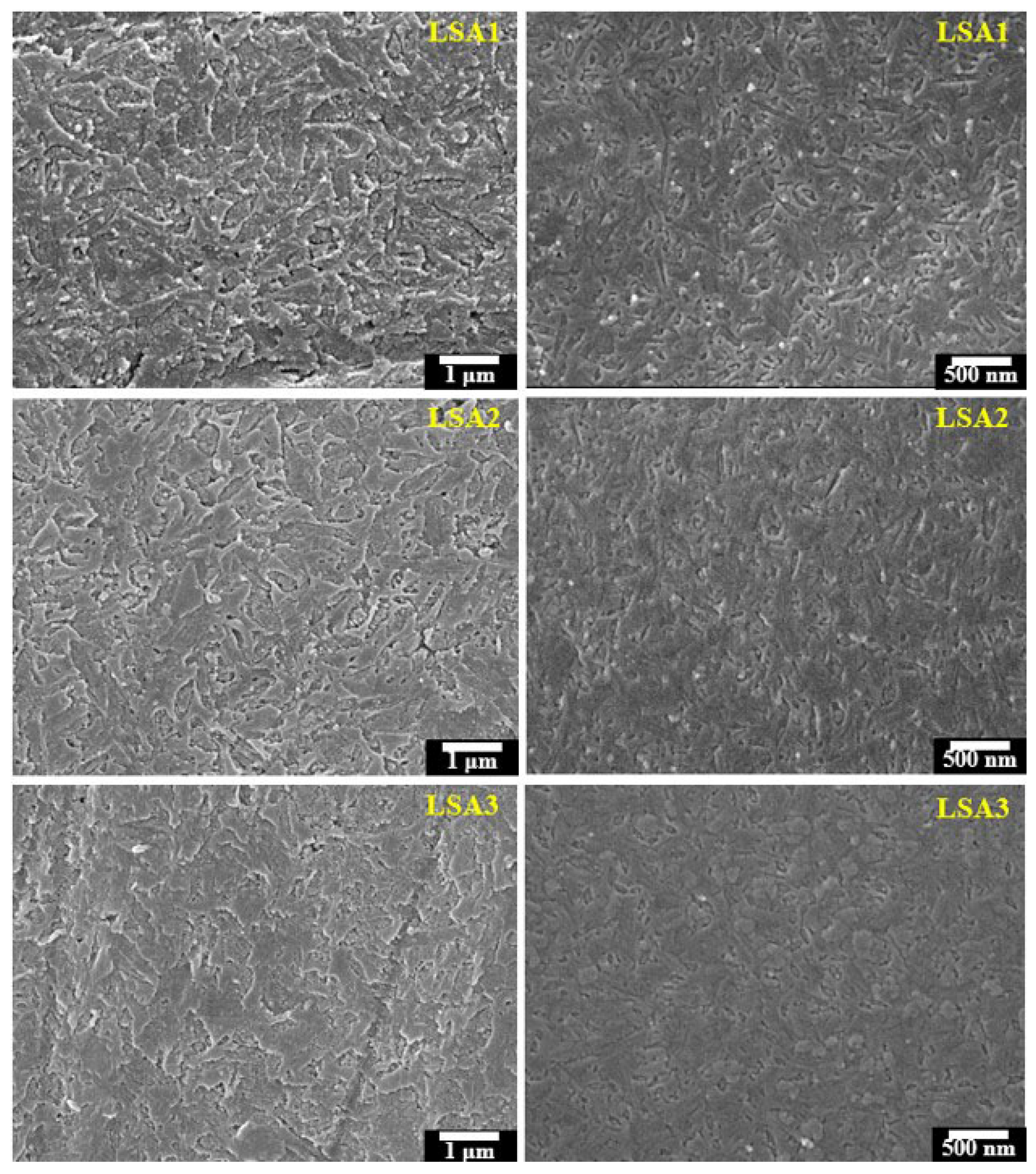
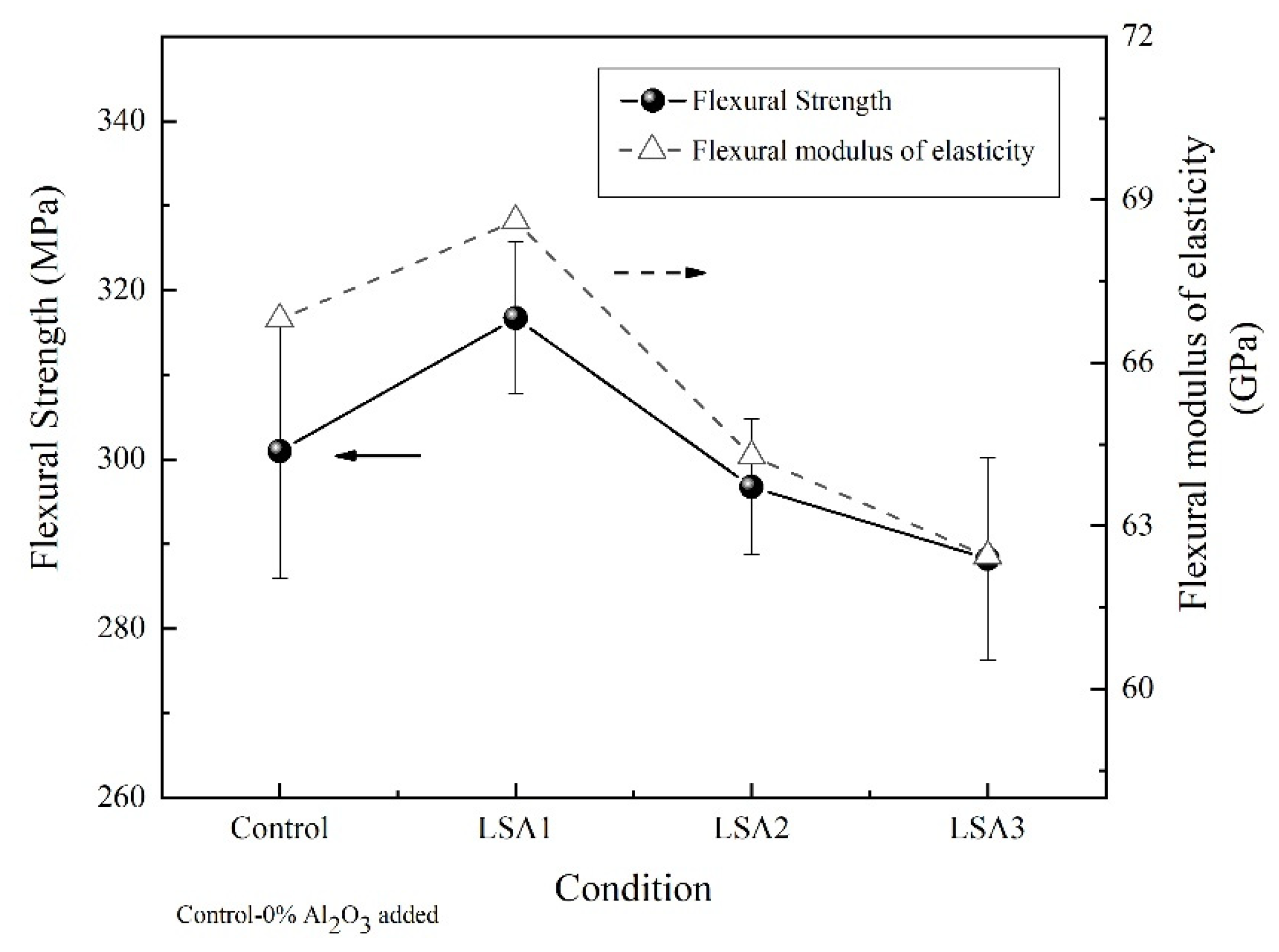
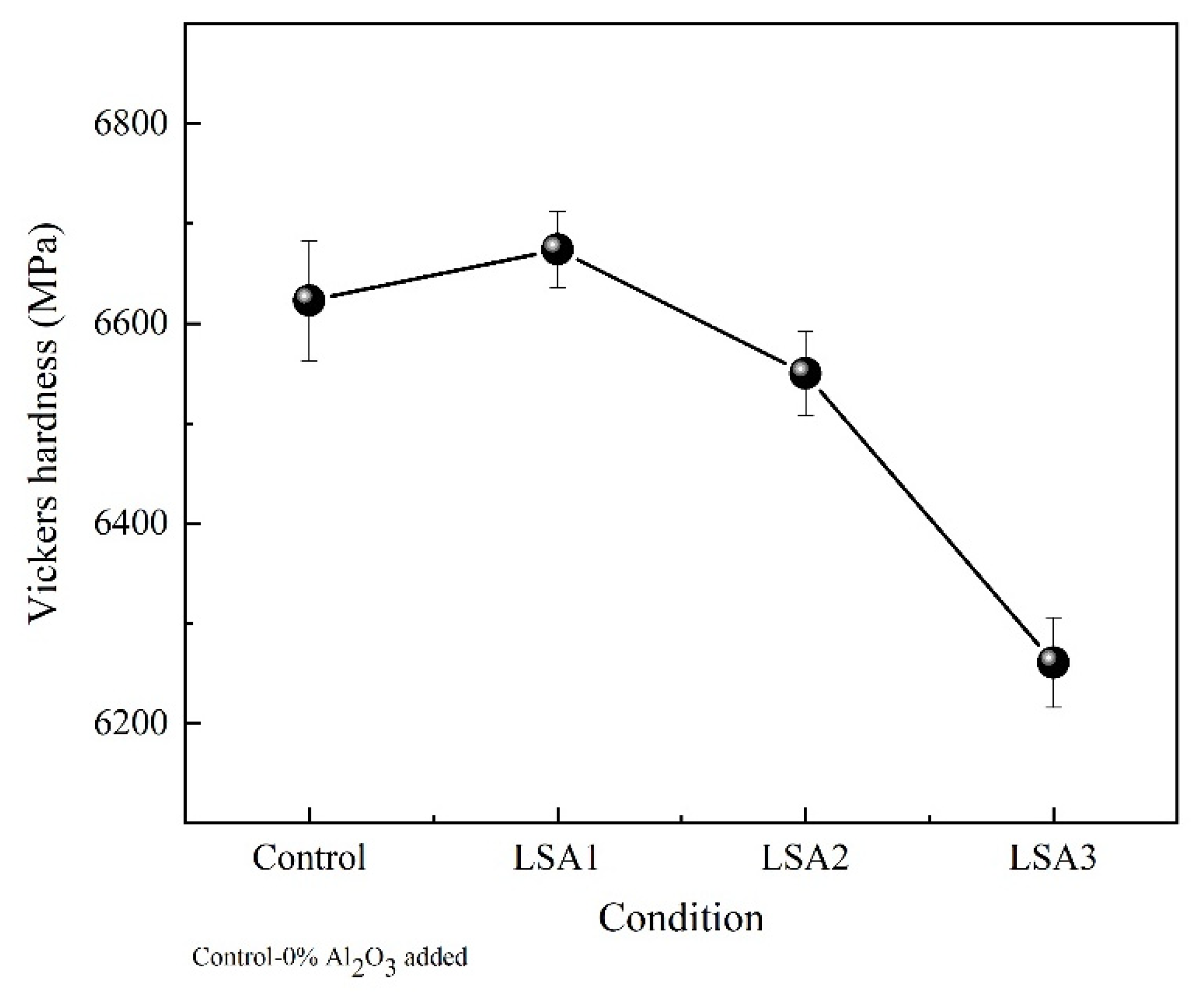
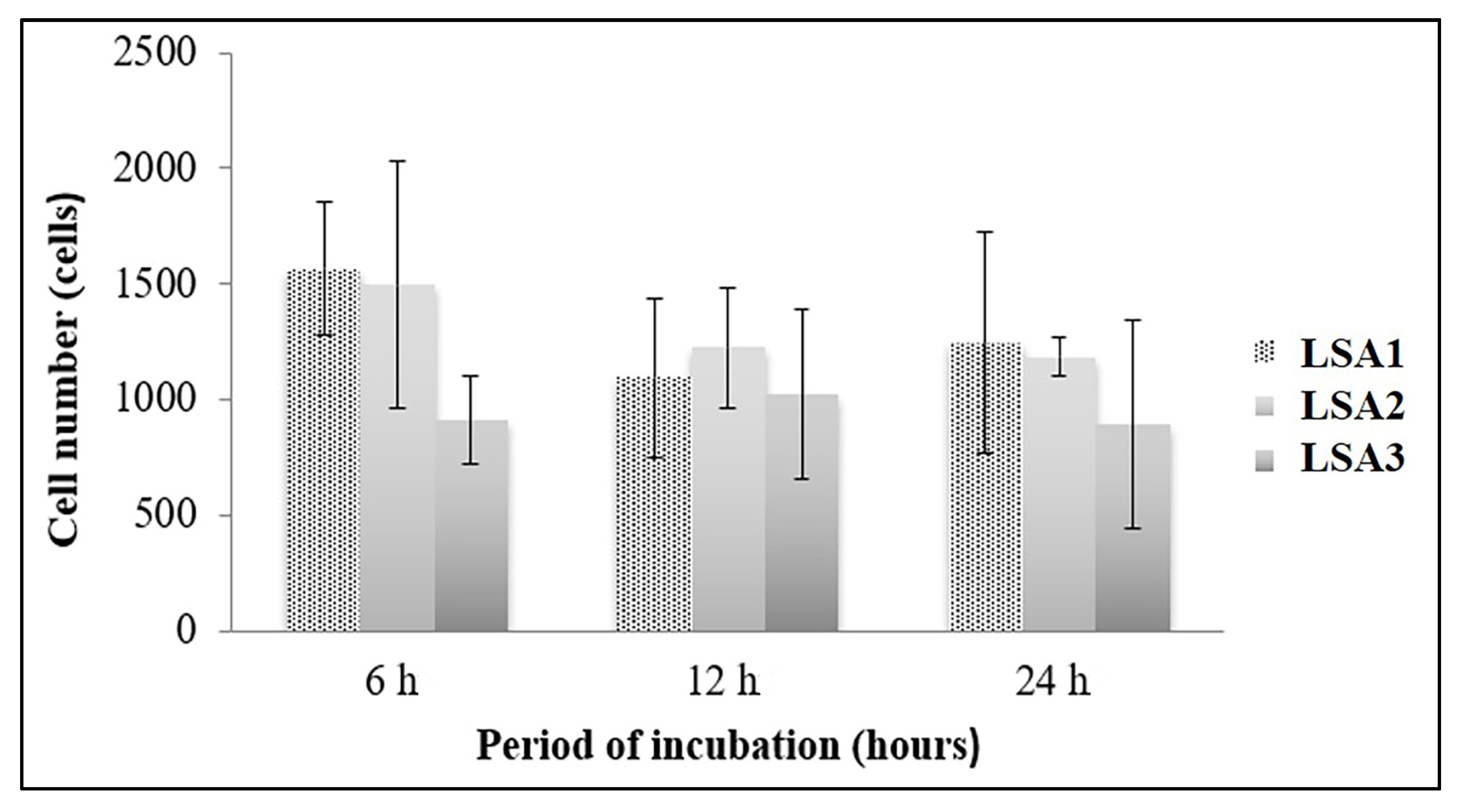
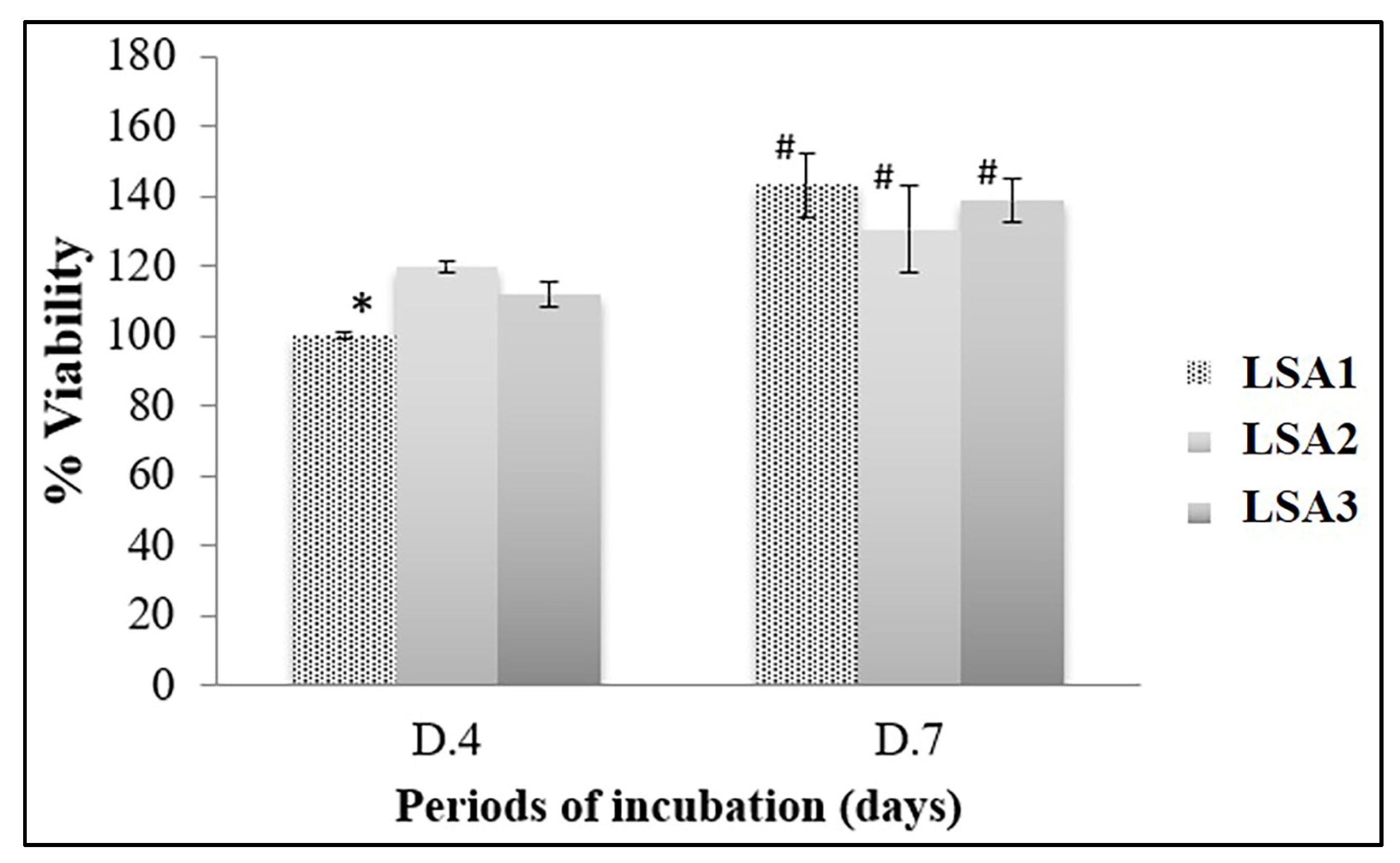
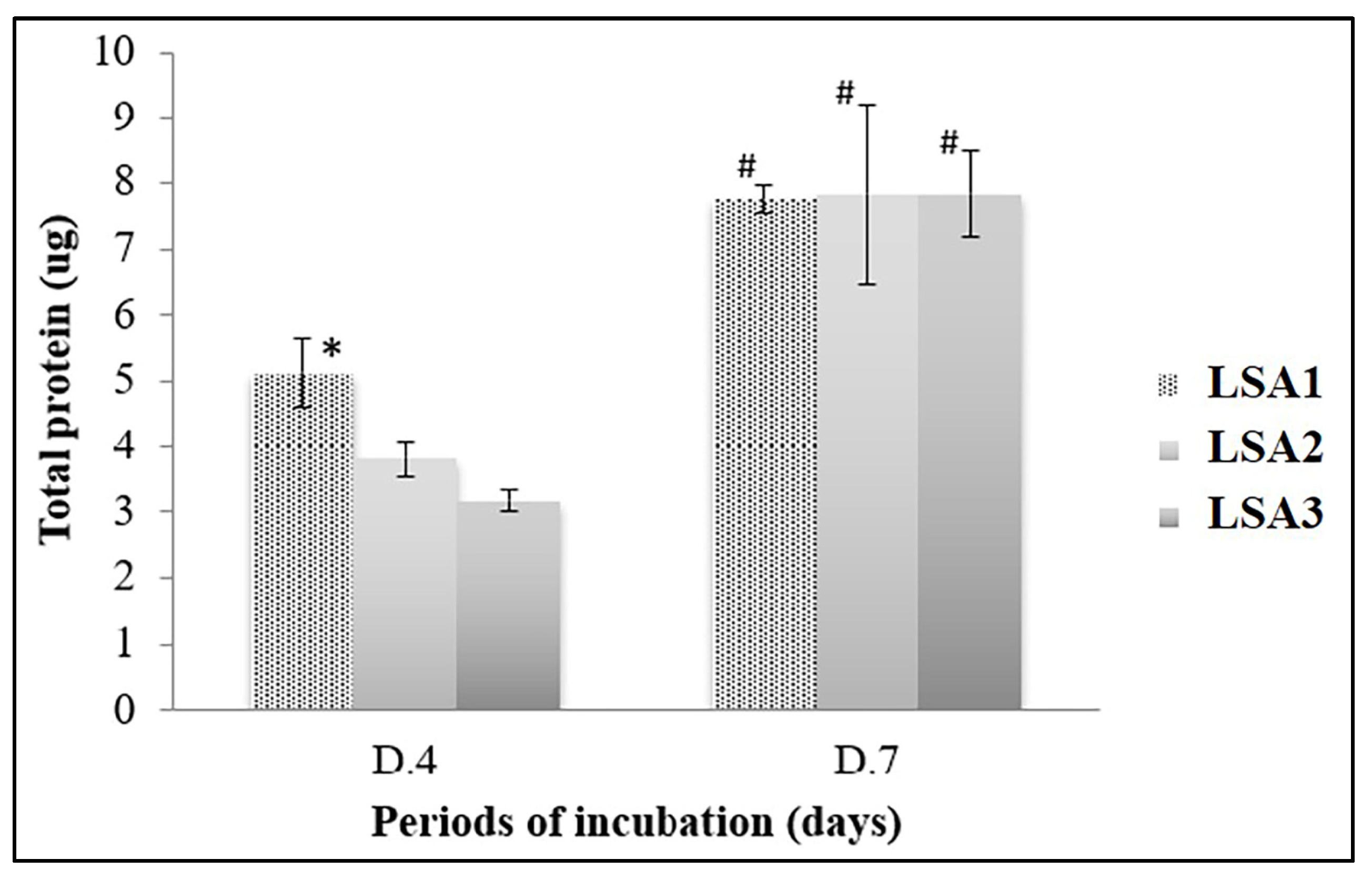
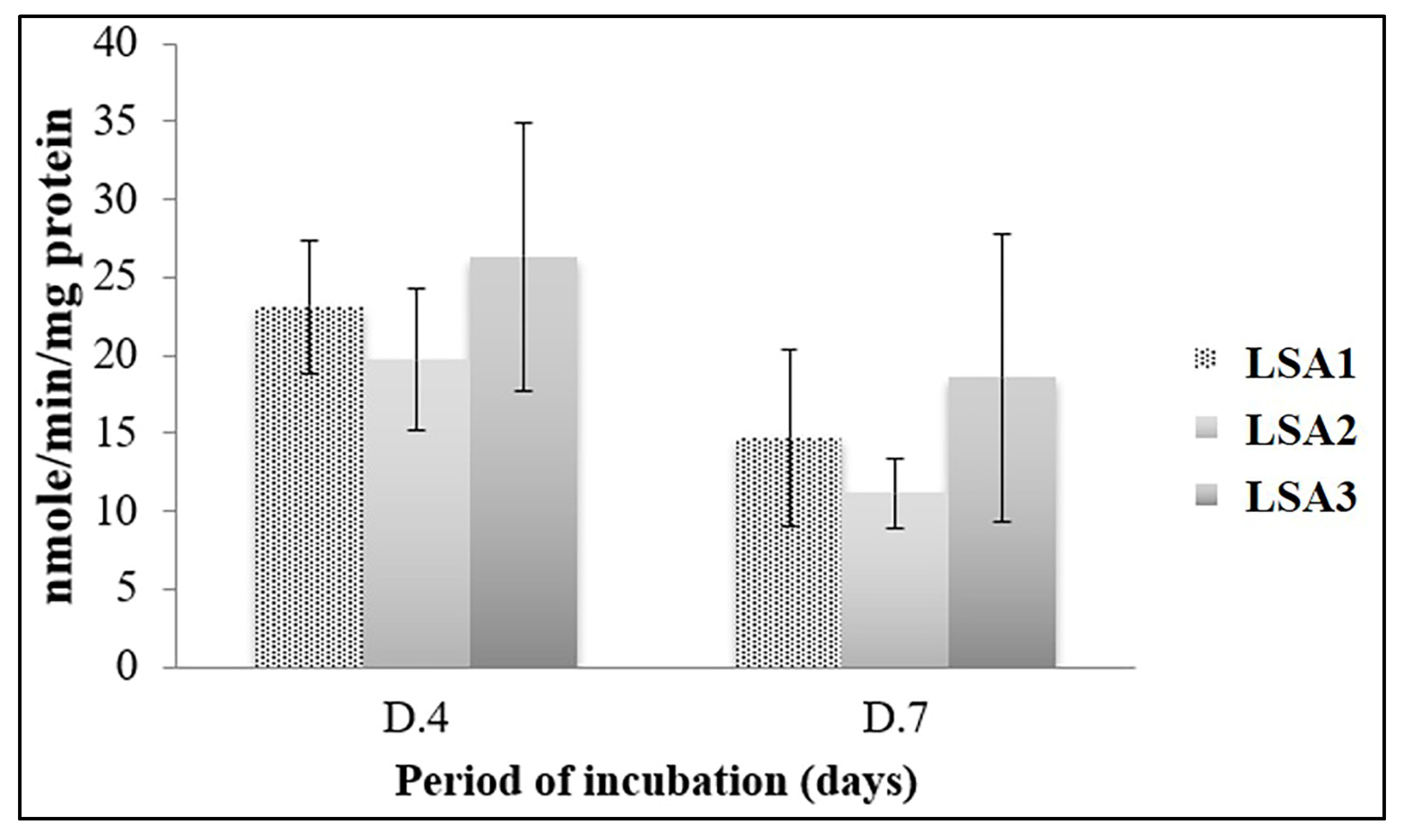

| Materials | Commercial Leucite (IPS Empress®) | Commercial Leucite (IPS Empress 2) | Commercial Lithium Disilicate | Lithium Disilicate | Lithium Disilicate |
|---|---|---|---|---|---|
| Flexural strength (MPa) | 90–130 | 400 | 400 | 350–450 | 316.72 |
| Vickers hardness (MPa) | 4001–6500 | 6500 | 5800 | 4001–6500 | 6685 |
| Ref. | [30,31] | [32] | [28] | [8,33] | This study (LSA1) |
| Surface Treatment | Microshear Bond Strength (Mean ± SD; MPa) | ||
|---|---|---|---|
| LSA1 | LSA2 | LSA3 | |
| No surface treatment (Control) | 3.69 ± 0.56 a | 3.47 ± 0.58 a | 3.23 ± 0.48 a |
| Silane coating | 34.20 ± 2.57 c | 37.21 ± 3.43 c | 37.97 ± 3.07 c |
| Hydrofluoric Acid | 20.92 ± 2.52 b | 20.74 ± 2.85 b | 19.34 ± 3.48 b |
| Hydrofluoric acid + Silane coating | 45.34 ± 2.40 d | 47.57 ± 4.05 d | 47.89 ± 3.10 d |
Publisher’s Note: MDPI stays neutral with regard to jurisdictional claims in published maps and institutional affiliations. |
© 2022 by the authors. Licensee MDPI, Basel, Switzerland. This article is an open access article distributed under the terms and conditions of the Creative Commons Attribution (CC BY) license (https://creativecommons.org/licenses/by/4.0/).
Share and Cite
Kraipok, A.; Mamanee, T.; Ruangsuriya, J.; Nawarat, P.; Leenakul, W. Phase Formation, Mechanical Strength, and Bioactive Properties of Lithium Disilicate Glass–Ceramics with Different Al2O3 Contents. Materials 2022, 15, 8283. https://doi.org/10.3390/ma15238283
Kraipok A, Mamanee T, Ruangsuriya J, Nawarat P, Leenakul W. Phase Formation, Mechanical Strength, and Bioactive Properties of Lithium Disilicate Glass–Ceramics with Different Al2O3 Contents. Materials. 2022; 15(23):8283. https://doi.org/10.3390/ma15238283
Chicago/Turabian StyleKraipok, Arnon, Teerapong Mamanee, Jetsada Ruangsuriya, Poomirat Nawarat, and Wilaiwan Leenakul. 2022. "Phase Formation, Mechanical Strength, and Bioactive Properties of Lithium Disilicate Glass–Ceramics with Different Al2O3 Contents" Materials 15, no. 23: 8283. https://doi.org/10.3390/ma15238283
APA StyleKraipok, A., Mamanee, T., Ruangsuriya, J., Nawarat, P., & Leenakul, W. (2022). Phase Formation, Mechanical Strength, and Bioactive Properties of Lithium Disilicate Glass–Ceramics with Different Al2O3 Contents. Materials, 15(23), 8283. https://doi.org/10.3390/ma15238283






